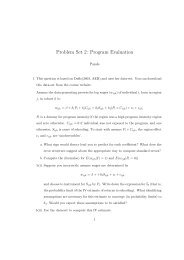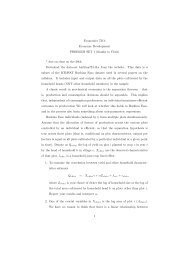The Expected Utility Model: Its Variants, Purposes, Evidence and ...
The Expected Utility Model: Its Variants, Purposes, Evidence and ...
The Expected Utility Model: Its Variants, Purposes, Evidence and ...
Create successful ePaper yourself
Turn your PDF publications into a flip-book with our unique Google optimized e-Paper software.
Schoemaker: <strong>The</strong> <strong>Expected</strong> <strong>Utility</strong> <strong>Model</strong><br />
537<br />
ficient (as well as necessary), without additional<br />
restrictions being imposed for logical<br />
or empirical reasons. <strong>The</strong> main<br />
consistency axiom of subjective probability<br />
theory is coherence (de Finetti, 1937).<br />
Informally, it requires that for a given belief<br />
system, it should not be possible for<br />
a clever bookmaker to lay multiple fair<br />
bets so that the bookmaker wins under<br />
all possible outcomes. This axiom (together<br />
with some others) implies that the<br />
probabilities of elementary events sum to<br />
one, <strong>and</strong> that conjunctive <strong>and</strong> disjunctive<br />
events follow the product <strong>and</strong> addition<br />
rules respectively. As such, subjective<br />
probabilities are mathematically indistinguishable<br />
from other types of probability.<br />
<strong>The</strong> subjective school developed measurement<br />
procedures for the simultaneous estimation<br />
of utility <strong>and</strong> probability as based<br />
on revealed preferences (Donald Davidson<br />
<strong>and</strong> Suppes, 1956).<br />
<strong>The</strong> important point is that probability<br />
is not a simple construct (Henry Kyburg<br />
<strong>and</strong> Howard Smokler, 1964). <strong>Its</strong><br />
measurement is obviously difficult in realworld<br />
settings, but may even be so in simple<br />
games of chance (Davidson, Suppes<br />
<strong>and</strong> Sidney Siegel, 1957). To distinguish<br />
subjective from objective probability, it<br />
shall be denoted by f(p). <strong>The</strong> f(.) transformation<br />
signals that the probabilities to be<br />
used in EU model may differ from the<br />
stated or objective ones assumed by the<br />
researcher. However, not all f(pt) transformations<br />
satisfying the properties of<br />
probability (such as B f(pi) = 1) should<br />
be viewed as degrees of belief. In the literature,<br />
f(pi) transformations have been<br />
proposed to reflect risk-taking attitudes<br />
(Jagdish H<strong>and</strong>a, 1977), to explore symmetry<br />
between the probability <strong>and</strong> outcome<br />
component in expectation models (Hans<br />
Schneeweiss, 1974), to reflect probability<br />
<strong>and</strong>/or variance preference (Edwards,<br />
1954a <strong>and</strong> 1954b), or simply to fit data<br />
under the assumption that preferences<br />
are non-linear in probability (John Quig-<br />
gin, 1980). Although these various models<br />
are commonly referred to as Subjective<br />
<strong>Expected</strong> <strong>Utility</strong> theory (SEU), the f(pi)<br />
transformation may not strictly be degree<br />
of belief measures.<br />
Apart from transformations that do preserve<br />
the properties of mathematical<br />
probability, various theories exist where<br />
this requirement is relaxed. In Table 1<br />
such probability transformations are denoted<br />
by pi), <strong>and</strong> will be called decision<br />
weights. To quote Daniel Kahneman <strong>and</strong><br />
Tversky (1979, p. 280), "decision weights<br />
are not probabilities: they do not obey the<br />
probability axioms <strong>and</strong> they should not be<br />
interpreted as measures of degree of belief."<br />
In prospect theory (Kahneman <strong>and</strong><br />
Tversky, 1979) decision weights are aimed<br />
at reflecting the impact of events on the<br />
overall attractiveness of gambles. As such<br />
they are monotonic with probability, but<br />
not necessarily linear.<br />
To summarize, there are several ways<br />
that utility <strong>and</strong> probability have been<br />
treated in EU models. Systematic combining<br />
of the different transformations discussed<br />
yields nine EU variants, which are<br />
shown in Table 1 together with their<br />
names <strong>and</strong> main originators.' Note that<br />
this table focuses on the allowable probability<br />
<strong>and</strong> outcome transformations of the<br />
various models. However, there are other<br />
differences as well. For example, in prospect<br />
theory the outcomes xi are defined<br />
on changes in financial position rather<br />
than on final asset position. Moreover, in<br />
descriptive models the outcome space<br />
may include such dimensions as regret,<br />
justifiability of one's choice, etc. Most of<br />
the models listed were advanced as descriptive<br />
ones, with the exception of von<br />
Neumann-Morgenstern <strong>and</strong> Savage. It is<br />
<strong>The</strong> subjective expected utility (SEU) model is<br />
also encountered outside the context of monetary<br />
bets. Victor Vroom's (1964) expectancy theory of<br />
work motivation shows formal parallels to EU theory,<br />
as do theories in learning, attitude formation, <strong>and</strong><br />
personality development (Edward Lawler, 1973).




